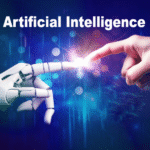Imagine a world where machines can think, learn, and solve problems almost like humans do. This is not just science fiction — it’s the transformative reality brought by Artificial Intelligence, or AI. But what exactly is AI, and why has it become such a buzzword in recent years? In this comprehensive post, we will explore what AI is in simple language, how it works, where it is used, its benefits, and its growing impact on our daily lives. Get ready for a journey into the world of tomorrow, powered by intelligent machines.
What is Artificial Intelligence?
Artificial Intelligence (AI) refers to the capability of machines, computers, or software to perform tasks that typically require human intelligence. These tasks include reasoning, problem-solving, understanding language, recognizing images, learning from experience, and making decisions. AI does not mean that a machine is as smart as a human in every way, but it can be trained or programmed to perform specific tasks with remarkable accuracy and efficiency.
A Brief History of AI
The concept of machines that can think dates back to ancient times, but the modern field of AI began in the 1950s. Researchers like Alan Turing and John McCarthy laid the foundation for computers to “think” and solve problems. Since then, AI has evolved rapidly, with advances in computer power, data availability, and mathematical algorithms.
Types of AI
There are three main categories of AI:
- Narrow AI: Also known as weak AI, this type specializes in one task. Examples include voice assistants like Siri or Alexa, and recommendation systems on Netflix or Amazon. Narrow AI excels at the specific task it is designed for but cannot perform tasks outside its domain.
- General AI: This is a theoretical form of AI that would possess the ability to understand, learn, and apply intelligence across a broad range of tasks, just like a human. General AI does not yet exist.
- Superintelligent AI: This is the concept of AI that surpasses human intelligence in every aspect. It belongs more to science fiction at the moment, but researchers debate its potential and implications for the future.
How Does AI Work?
AI works by using algorithms, which are sets of rules or instructions, to process data, recognize patterns, and make decisions. The two key components that make modern AI powerful are:
- Machine Learning (ML): Machine learning is a subset of AI that enables computers to learn from data without being explicitly programmed. The more data it receives, the better it can make predictions or decisions.
- Deep Learning: This is a more advanced kind of machine learning that uses artificial neural networks (inspired by the human brain) to handle complex tasks such as image and speech recognition.
For example, when you upload a photo to social media and it suggests who is in the picture, that’s AI at work using deep learning.
Uses of AI in Everyday Life
AI is not just a concept in movies; it’s already woven into the fabric of our daily routines. Here are some ways you interact with AI almost every day:
- Smartphones: The voice assistants in your phone, predictive text, and even the camera’s face detection all use AI to make your experience smoother.
- Social Media: Platforms like Facebook, Instagram, and Twitter use AI to recommend content, filter spam, and detect harmful posts.
- Streaming Services: Services like Netflix and YouTube use AI to suggest shows and videos you might like based on your viewing habits.
- Email: Spam filters, smart replies, and sorting features are all powered by AI algorithms.
- Online Shopping: E-commerce sites recommend products, personalize offers, and even chat with you using AI-driven chatbots.
- Navigation: Google Maps and other GPS apps use AI to analyze traffic data and give you the fastest route.
- Healthcare: AI helps doctors diagnose diseases, predict outbreaks, and personalize treatment plans.
- Banking and Finance: AI detects fraudulent transactions, automates customer service, and helps manage investments.
- Home Automation: Smart speakers, thermostats, and security systems use AI to adapt to your preferences and routines.
AI’s reach is expanding rapidly, and its applications are only limited by our imagination.
Benefits of AI
AI brings a multitude of benefits that are reshaping industries, enhancing productivity, and improving quality of life. Here’s how:
- Efficiency and Automation: AI automates repetitive tasks, allowing people to focus on more creative or complex work. For instance, robots in factories can assemble products faster and more accurately than humans.
- Personalization: From music recommendations to shopping suggestions, AI tailors experiences to individual preferences, making services more relevant and engaging.
- Improved Decision Making: AI analyzes massive amounts of data quickly, enabling better-informed decisions in areas like business, healthcare, and finance.
- smart assistants
- Cost Reduction: By automating processes, AI can reduce operational costs and boost profitability for businesses.
- New Discoveries: AI accelerates research in science, medicine, and technology, leading to breakthroughs such as faster drug discovery and improved climate modeling.
- Enhanced Safety: AI can monitor environments for hazards, operate autonomous vehicles, and predict equipment failures before they cause accidents.
The Effect of AI in Daily Life
AI’s impact is everywhere, often in subtle ways that go unnoticed. Here’s how it is changing the world we live in:
At Home
AI makes our homes smarter and more comfortable. Smart devices can learn your habits, adjust the lights and temperature, play your favourite music, and even order groceries for you. AI-powered vacuum cleaners map your floors and clean efficiently. Security cameras recognize faces and alert you to unusual activity.
At Work
Many workplaces use AI to streamline tasks, schedule meetings, or sort emails. In customer service, AI chatbots handle queries instantly, freeing up human agents for complex cases.
Education Sector
AI enables personalized learning experiences, adapting lessons to a student’s level and pace. Teachers use AI to grade assignments, identify when students need help, and provide targeted resources. Online platforms deliver interactive courses, while AI tutors offer support 24/7.
Healthcare Revolution
AI is transforming healthcare by helping doctors diagnose diseases from scans, monitor patients remotely, and develop new treatments. Predictive AI models can identify individuals at risk for certain conditions, leading to early interventions and better outcomes.
On the Road
Self-driving cars, though not yet mainstream everywhere, use AI to perceive their surroundings, make quick decisions, and avoid accidents. Navigation apps consider real-time traffic data to recommend optimal routes, saving time and reducing congestion.
Shopping and Entertainment
AI personalizes your shopping experience by suggesting products, applying discounts, and predicting what you need before you even realize it. In entertainment, AI creates curated playlists, recommends movies, and even generates art or music tailored to your taste.
Financial Services
Banks and financial institutions use AI for fraud detection, customer support, and risk assessment. Robo-advisors help people invest by analysing markets and suggesting portfolios that align with their goals.
Communication and Social Media
AI-driven algorithms ensure that the content you see on social media is relevant and engaging. Spam filters protect your inbox from junk emails, while language translation tools allow instant communication with people all over the world.
Challenges and Ethical Concerns of AI
While AI offers tremendous benefits, it also raises important questions and challenges:
- Job Displacement: As AI automates more tasks, some traditional jobs may become obsolete, requiring people to learn new skills or transition to different roles.
- Privacy Issues: AI systems often rely on vast amounts of data, which can raise concerns about how personal information is collected and used.
- Bias and Fairness: If the data used to train AI contains biases, the AI may make unfair or discriminatory decisions.
- Security Risks: Hackers can exploit AI systems for malicious purposes, such as creating deepfakes or bypassing security measures.
- Lack of Transparency: Some AI algorithms are so complex that even their creators cannot fully explain how they make decisions, which can be problematic in critical situations.
- Misinformation: AI-generated content, such as fake news or manipulated videos, can spread misinformation quickly and undermine trust.
The Future of AI
AI is still in its infancy, with vast potential yet to be realized. Here are some predicted trends and possibilities:
- Smarter Assistants: AI-powered virtual assistants are expected to become even more intelligent, understanding context, emotions, and providing proactive support.
- Healthcare Innovations: AI will play a bigger role in disease prevention, drug discovery, personalized medicine, and remote care.
- Autonomous Vehicles: Self-driving cars, drones, and delivery robots are likely to become more common, changing how we move and transport goods.
- Environmental Solutions: AI will help tackle climate change by optimizing energy use, predicting weather patterns, and managing resources efficiently.
- Enhanced Education: Adaptive learning platforms, AI tutors, and smart classrooms will make education more accessible and effective.
- Creative AI: AI will continue to create music, art, stories, and even assist in scientific discoveries, pushing the boundaries of human creativity.
How to Prepare for an AI-Driven World
AI is here to stay, so it’s important to adapt and make the most of its capabilities. Here are some tips to thrive in an AI-powered future:
- Learn Continuously: Stay curious and keep learning about AI and related technologies. Free resources, online courses, and articles can help you understand the basics and more advanced concepts.
- Develop Tech Skills: Coding, data analysis, and understanding how AI works can open up job opportunities and make you more adaptable.
- Focus on Human Skills: Creativity, empathy, problem-solving, and communication are skills that AI cannot easily replicate. These will be highly valued as automation increases.
- Protect Your Privacy: Be mindful of the information you share online and understand how companies use your data.
- Engage in Ethical Discussions: Participate in conversations about how AI should be used, and advocate for fairness, transparency, and accountability.
Conclusion: Embracing AI Responsibly
Artificial Intelligence is reshaping the way we live, work, learn, and interact. Its power lies in its ability to process information, recognize patterns, and automate tasks, improving efficiency and creating new opportunities. From household gadgets to complex medical systems, AI touches every aspect of our lives. While it presents challenges, particularly around ethics and employment, its benefits are vast and transformative.
Understanding AI, staying informed, and actively participating in its development are key to harnessing its full potential. As AI continues to evolve, it is up to us to ensure that its growth aligns with human values and serves the greater good.
Every day, AI becomes less of a distant dream and more of a helpful companion in our daily routines. The future promises even greater advancements, and by embracing AI responsibly, we can build a smarter, safer, and more connected world for generations to come.


